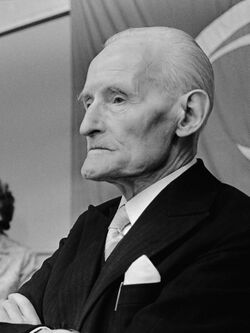Unsolved:Moerman Therapy
The Moerman Therapy, also called Moerman Method or Moerman Diet is a purported cancer treatment from the Dutch practitioner Cornelis Moerman (nl) (1893–1988). Its effectiveness is supported by anecdote only – there is no evidence of its worth as a cancer treatment.[1][2]
History
Moerman who experimented with pigeons in the 1930s argued that he had identified "mysterious suppressors" of the cancer cell and there are "eight essential substances" that maintain human health.[2] He claimed that deficiency of these substances leads to metabolic disturbances and anomalies of regeneration tissue that enable microorganisms which he termed "symbionts" to convert healthy cells into cancer cells.[2]
According to Quackwatch the Moerman diet is a lacto-vegetarian diet that "prohibited all meats, all fish and shellfish, alcohol, animal fats, artificial colorings, beans, peas, lentils, mushrooms, potatoes, red cabbage, saurkraut [sic], cheeses with high fat and salt content, margerine [sic] and other hydrogenated oils, coffee, cocoa or caffeine containing [sic] teas, egg whites, sugar, salt, white flour, and tobacco."[2] The alleged "symbionts" that Moerman proposed have never been shown to exist.[2]
In 2000, Moerman's invention of the diet earned him a place at the head of "a list of the twenty biggest quacks of the twentieth century" as decided by the Dutch Union Against Quackery.[3]
See also
- List of ineffective cancer treatments
References
- ↑ "Alternative cancer treatment". National Center for Complementary and Integrative Health. http://paseka.us/alternative-cancer/. Retrieved 2011-03-13.
- ↑ 2.0 2.1 2.2 2.3 2.4 Stephen Barrett, M.D. (11 December 2001). "The Moerman Diet". Quackwatch. http://www.quackwatch.org/01QuackeryRelatedTopics/Cancer/moerman.html. Retrieved May 1, 2013.
- ↑ Dutch Quackbuster chooses biggest quacks of the 20th century. NCRHI Newsletter November 2000: 2.
 |


